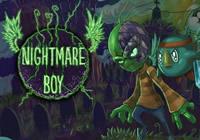Nightmare Boy (PC) Review
By Kevin Tsai  24.01.2018
24.01.2018

Metroidvanias have been a staple of videogaming ever since hardware became powerful enough to render 2D characters with tight controls. In the recent resurgence of newly developed games with an old school aesthetic and mindset, Nightmare Boy is in direct competition with a horde of excellent Metroidvanias, such as Ori and the Blind Forest, Hollow Knight and Dead Cells. Unfortunately, Nightmare Boy's colourful presentation and intriguing story bites aren't enough to elevate it above the rest in this crowded genre.
Nightmare Boy is a 2D platformer developed by The Vanir Project, the first project from a team of just two people, and in some ways it shows. However, it is undeniable that the aesthetics of this title are impressive for a first effort. According to interviews, both team members had to learn how to animate and programme nearly from scratch, and as a first attempt, it is a success. The game's visuals come off like one of those children's Saturday morning animated shows that hide some pretty disturbing themes and situations underneath its cartoon surface, comparable to something like Invader Zim or Real Monsters.

If anything, there might be too much colour; the background and foreground are just popping constantly with every shade imaginable, which ends up being quite messy and difficult to follow. Billy, the protagonist of the story, is transformed into a monster by a talking pillow who wants to take him to a kingdom to impress an evil queen. Not being the biggest fan of this kidnapping, Billy must explore the world, saving other children and fighting nightmare creations to wake them up and bring them back up to the real world. The storyline is fine for this kind of game, but is pretty vague and difficult to follow, but this can be attributed to a loss in translation as English isn't the Nightmare Boy developer's first language.
The music is excellent, with different themes depending on what level you are in. In addition to the expected fire and ice tropes of other Metroidvanias, there are also some more interesting locations, such as a candy-infused world full of emaciated children in the background, or a stalactite filled cavern full of machinery. The sound effects, on the other hand, can be grating, since they are repeated quite often during gameplay. Regardless, Nightmare Boy's strongest asset is its audio and visual design, but where it ultimately mis-steps is in gameplay mechanics.

Nightmare Boy clearly wants to cash in on gamers' nostalgia for older, difficult 2D platformers, adhering to many of the same design principles of older titles. The game, for example, always feels excessively zoomed in on the main character, which in the past was a hardware-based limitation, but leads to many blind jumps and off-screen enemies that can surprise and damage you. There are also headache-inducing scan lines, which are thankfully disabled by default, but there is still a strange film on everything, as if the game is being viewed through an old CRT monitor. Controls are never as tight as they should be; there are no options for a longer or shorter jump, for instance - just tap jump and it's the maximum distance the character will jump. Combat usually boils down to simple button mashing beat down, and most abilities are some variation of a ranged attack.
The levels in the open world of Nightmare Boy are platforming challenges peppered with a wide variety of enemy types, which show off great creativity, but in practice fighting them boils down to the same 'punch them until they die' technique. The main McGuffin of this particular Metroidvania is children trapped in the nightmare world who must be saved, and are all guarded by a boss. These bosses require a lot of skill and mastery to defeat, but unfortunately the looseness of the controls make it more difficult than it should be. It is a difficult title, which is exacerbated by the save system. Throughout the experience, gems are obtained, which can be used to purchase additional upgrades, but these gems are also used to save the game at set save points, with incremental costs each time the player attempts to save. This system is tedious and ultimately pointless, as gems are readily available throughout the level, which leads to boring grinding for gems just to save progress.

Despite these issues, there are some novel, interesting ideas in Nightmare Boy. Near the beginning, and throughout every level, cute creatures called Mongos, which look a bit like Zoombinis, are harmlessly lounging about, but can be killed by the player. Later on, an elder Mongo chastises the player for murdering his people, and a specific ability summons a sword-wielding Mongo who will attack the player for harming his brethren. There hasn't been a Metroidvania in recent memory that makes the player actively avoid friendly fire, which prevents each level from being mindlessly punched through by constantly attacking. There are also hidden dreamers scattered throughout the level who have specific requests for Billy, and this can ultimately influence the ending of the game, but, unfortunately, not many players will want to replay this to find all of its hidden secrets.

Cubed3 Rating
Good
Nightmare Boy is an admirable first attempt by a two-person studio, with a compelling artistic vision backed up by wild and unexpected creativity. However, strict adherence to outdated gameplay tropes and questionable narrative pacing make this a difficult game to recommend to everyone, especially with the abundance of other high quality Metroidvanias on the market.

![]() 6/10
6/10
![]() 0
(0 Votes)
0
(0 Votes)
 Out now
Out now  Out now
Out now  Out now
Out now  Out now
Out now Comments
Comments are currently disabled

 Sign In
Sign In Game Details
Game Details Subscribe to this topic
Subscribe to this topic Features
Features





 Top
Top

